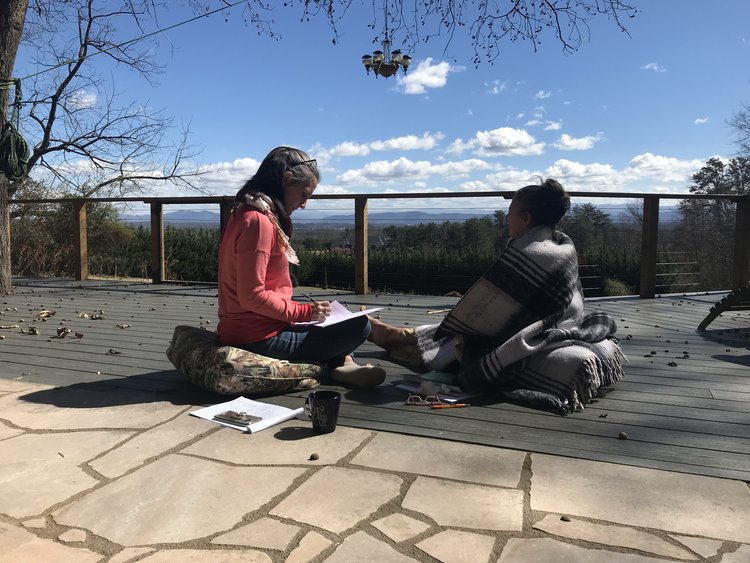“HOW DO YOU DETERMINE EMBODIMENT SUGGESTIONS FOR CLIENTS IN THEIR HOME PRACTICE?”
That was one of the questions that came up last weekend in the AAIT Essentials training. After all, homework is a familiar aspect of many models of care. The more we can help each other and our clients unpack the ins and outs of a successful embodiment practice, the better off we all are.
First, consider that embodiment in general in AAIT is about helping our clients embody their truest self, their preferred state, and their highest goals. This can mean embodying the energy of their charged pain. Luckily we have ways to help them do that without getting bogged down and stuck in it.
Note that embodiment as a practice is best supported by finding a regular time and place to practice. Most of us don’t keep our toothbrushes in the living room nor do we brush our teeth when cooking dinner. Brushing our teeth LIVES in a particular time and place. That said, helping our clients embrace embodiment practice can begin with supporting them in learning “walking around” practices to restore their state – such as End of Words.
Back to the question. As I’m listening to clients, I’m tracking the biggest points of pain and charged polarities that may be in play. We can hear this by listening closely past the storyline to the language used by our clients.
In addition to these notes, I draw from the stabilization questions if we did not get to address them in our session:
- Future Clearing – Is it possible for the problem to impose itself on them in the future AGAINST THEIR WILL?
- Wholistic Processing – Are their other points of view (POV) that need to be considered?
- Loop back to the narrative in their session, are there any dangling threads they can address in their home practice?
- RESOURCING – Increasing our clients’ resourcing capacity is perhaps the primary reason we work to help our clients develop a supportive embodiment practice. They learn to access resources within themselves that support them in restoring and sustaining a satisfying state of being while moving towards their goals.
In addition to how embodiment increases our resourcing capacity, we can use resourcing as a practice itself with DP4 Golden Shadow work and Basic PEAT backwards (dubbed Sneaky PEAT by the brilliant wit of Jo Willey)
How do you determine what embodiment practices to recommend to your clients AND how do you support them in following through?
P.S. The last day of the training was a sunny Sunday morning. FINALLY!



I really like your blog.. very nice colors & theme. Did you make this website yourself or did you hire someone to do it for you? Plz respond as I’m looking to create my own blog and would like to know where u got this from. many thanks
http://www.oprolevorter.com/
Pretty nice post. I just stumbled upon your blog and wanted to say that I have truly enjoyed browsing your blog posts. After all I will be subscribing to your rss feed and I hope you write again soon!
https://www.eyestemcellcenter.com/
Thanks for your personal marvelous posting! I seriously enjoyed reading it, you happen to be a great author.I will make sure to bookmark your blog and definitely will come back at some point. I want to encourage one to continue your great writing, have a nice weekend!
https://www.eyestemcellcenter.com/
Hello, i think that i saw you visited my blog thus i came to “return the favor”.I’m attempting to find things to improve my site!I suppose its ok to use some of your ideas!!
https://anabolisants.shop/
Hello, i believe that i saw you visited my website so i got here to “return the favor”.I’m attempting to find issues to enhance my site!I assume its good enough to make use of a few of your concepts!!
https://best-globalpharma.co/
Nice read, I just passed this onto a colleague who was doing some research on that. And he actually bought me lunch as I found it for him smile Thus let me rephrase that: Thank you for lunch! “But O the truth, the truth. The many eyes That look on it The diverse things they see.” by George Meredith.
https://best-globalpharma.org/
I genuinely enjoy reading through on this web site, it contains fantastic posts.
https://www.gewichtverlieren.shop/
Thank you, I’ve just been looking for information about this subject for a while and yours is the best I’ve found out till now. But, what about the conclusion? Are you positive about the supply?
https://fortia.org/en/index.html
Sweet blog! I found it while browsing on Yahoo News. Do you have any suggestions on how to get listed in Yahoo News? I’ve been trying for a while but I never seem to get there! Thank you
https://levelextreme.net/
Way cool, some valid points! I appreciate you making this article available, the rest of the site is also high quality. Have a fun.
https://ladiesfitnesswear.com/